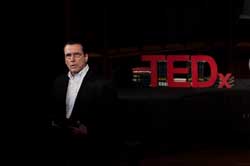Putting Kids On The Case
To engage young people in learning, Jack McGourty poses real-world problems ranging from designing a robot to running a business
By Barbara Finkelstein
From his earliest days teaching Columbia first-year students basic engineering and product design, Jack McGourty has employed a method that rests on three key components:
→ Teach the theory
→ Create experiments that can be done in the classroom
→ Work on a problem out in the real world
“It’s a fail-proof model,” says McGourty, Director of Community and Global Entrepreneurship at the Columbia Business School, where he teaches graduate courses in entrepreneurship, venture creation and technology management. “I use it in the classroom and behind an administrator’s desk.”
In his former role as Vice Dean of Columbia’s Fu Foundation School of Engineering and Applied Science, McGourty adapted that model to the Harlem Schools Partnership, a joint effort between the engineering school and Teachers College to improve the teaching of science, technology, engineering and math (the so-called STEM subjects) at a group of public schools in Harlem and Upper Manhattan.
McGourty began laying the groundwork for the engineering school’s participation in that partnership in 2006, when he established the Center for Technology, Innovation and Community Engagement (CTICE). In 2009 he joined forces with TC’s Office of School and Community Partnerships, headed by Associate Vice President Nancy Streim, to win backing for the effort from the GE Foundation. Since then, doctoral students from TC and Columbia Engineering have been getting kids of all ages excited about robotics, green audits, cyber safety and a host of other STEM-related topics.
“We have all sat in math and science classrooms where we were taught to find one right answer,” says McGourty, who received his M.S. in Clinical Psychology from Teachers College in 2002 and completed a Post-Doctoral Re-specialization Program in Clinical Psychology at the College that same year. “This kind of thinking works for computing two plus two, but it won’t solve open-ended problems like how to create energy-efficient buildings or even how to design a video game.”
In focusing on real-world problem solving, McGourty, who also holds a Ph.D. in Applied Psychology from Stevens Institute of Technology, often emphasizes the connection between the STEM subjects and running a business. Through CTICE, for example, he established the Columbia-Harlem Small Business Development Center (SBDC), a federally-funded project that links students to local businesses and supports job creation in the community. He also introduced a 15-credit interdisciplinary undergraduate minor in entrepreneurship that combines the development of engineering skills with a commitment to community service.
McGourty won corporate sponsorship for these CTICE programs in part through his own adroit entrepreneurship, but also because of his genuine belief that through such efforts, teachers and students can change the way they think and make life everywhere a little better.
Many students are showcasing work they began in one of McGourty’s community-based programs. Victoria Nneji, a sophomore at the engineering school, founded Digital STEM, a grant-funded project that teaches elementary- and middle-school students how to refurbish used computers. Andrea Sreshta and Anna Stork, 2011 graduates of Columbia’s Graduate School of Architecture, Planning and Preservation who went through the CTICE entrepreneurship program, developed a solar lantern that they are now selling through their company, LuminAID Lab, as a disaster relief light source to people in Haiti, Ghana and Nigeria.
Currently, McGourty is the driving force behind In-V-Ent-Ed™, a new program to educate aspiring entrepreneurs across the globe. He is forging partnerships with corporations, governments, NGOs and academic institutions to support regional innovation and economic development. This year he will be teaching hundreds of high school students in China, India, Turkey and the United Arab Emirates about entrepreneurship and innovation.
“I’m a big believer that if we can get students to use their STEM skills with entrepreneurial passion, we’ll see global challenges solved, such as buildings using energy more efficiently,” McGourty says. “And we’ll see young people use data to solve big public health issues.”
Published Wednesday, May. 2, 2012
